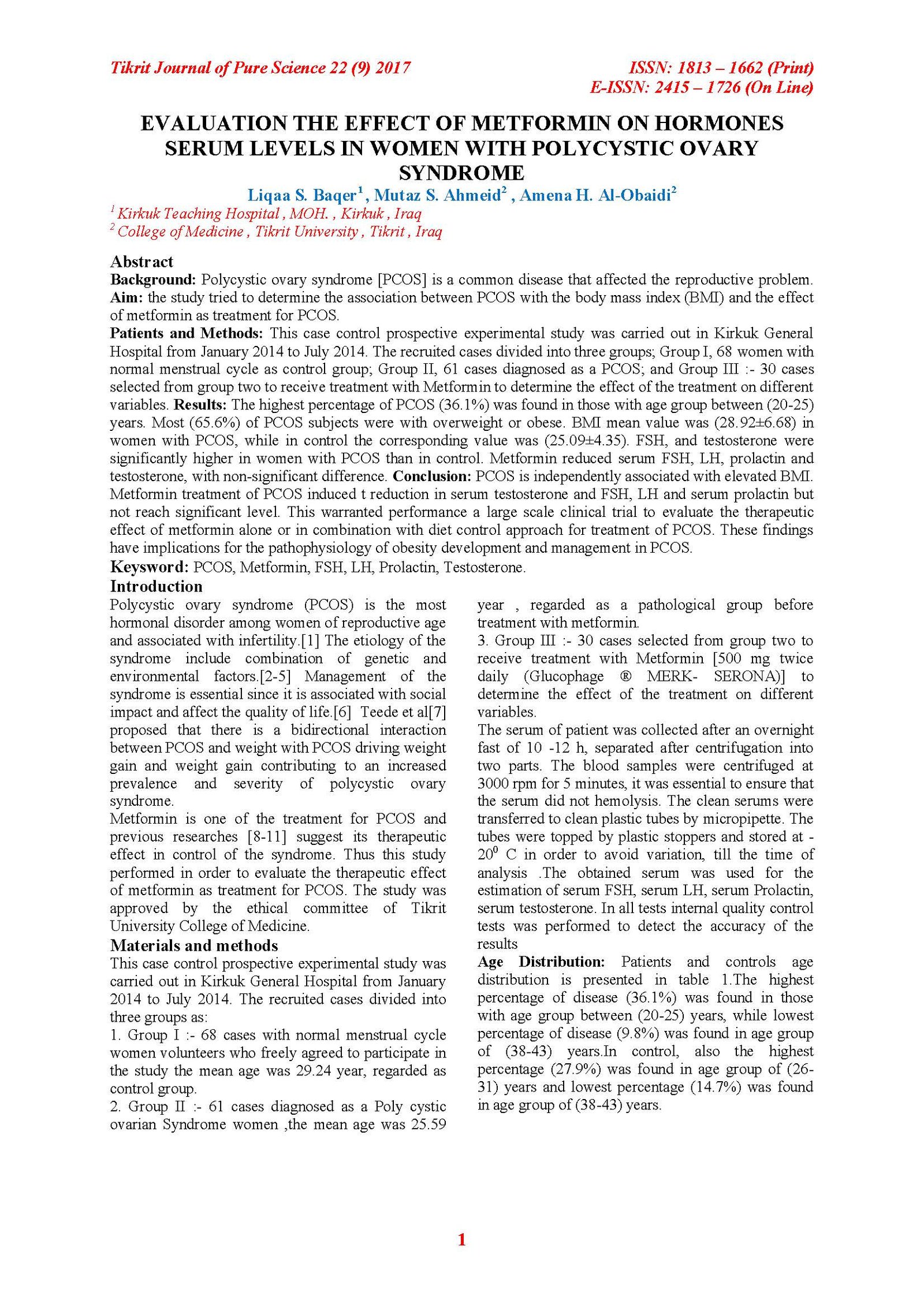EVALUATION THE EFFECT OF METFORMIN ON HORMONES SERUM LEVELS IN WOMEN WITH POLYCYSTIC OVARY SYNDROME
Main Article Content
Abstract
Background: Polycystic ovary syndrome [PCOS] is a common disease that affected the reproductive problem. Aim: the study tried to determine the association between PCOS with the body mass index (BMI) and the effect of metformin as treatment for PCOS.
Patients and Methods: This case control prospective experimental study was carried out in Kirkuk General Hospital from January 2014 to July 2014. The recruited cases divided into three groups; Group I, 68 women with normal menstrual cycle as control group; Group II, 61 cases diagnosed as a PCOS; and Group III :- 30 cases selected from group two to receive treatment with Metformin to determine the effect of the treatment on different variables. Results: The highest percentage of PCOS (36.1%) was found in those with age group between (20-25) years. Most (65.6%) of PCOS subjects were with overweight or obese. BMI mean value was (28.92±6.68) in women with PCOS, while in control the corresponding value was (25.09±4.35). FSH, and testosterone were significantly higher in women with PCOS than in control. Metformin reduced serum FSH, LH, prolactin and testosterone, with non-significant difference. Conclusion: PCOS is independently associated with elevated BMI. Metformin treatment of PCOS induced t reduction in serum testosterone and FSH, LH and serum prolactin but not reach significant level. This warranted performance a large scale clinical trial to evaluate the therapeutic effect of metformin alone or in combination with diet control approach for treatment of PCOS. These findings have implications for the pathophysiology of obesity development and management in PCOS.
Article Details

This work is licensed under a Creative Commons Attribution 4.0 International License.
Tikrit Journal of Pure Science is licensed under the Creative Commons Attribution 4.0 International License, which allows users to copy, create extracts, abstracts, and new works from the article, alter and revise the article, and make commercial use of the article (including reuse and/or resale of the article by commercial entities), provided the user gives appropriate credit (with a link to the formal publication through the relevant DOI), provides a link to the license, indicates if changes were made, and the licensor is not represented as endorsing the use made of the work. The authors hold the copyright for their published work on the Tikrit J. Pure Sci. website, while Tikrit J. Pure Sci. is responsible for appreciate citation of their work, which is released under CC-BY-4.0, enabling the unrestricted use, distribution, and reproduction of an article in any medium, provided that the original work is properly cited.
References
1. Kollmann, M.; Martins, WP. and Raine-Fenning,
N. (2014). Terms and thresholds for the ultrasound
evaluation of the ovaries in women with
hyperandrogenic anovulation. Hum. Reprod. 20(3):
463.
2. Mark, O.; Daniel, A.; Gregorio, C.; and Ricardo,
A.(2011). Polycystic ovary syndrome: etiology,
pathogenesis and diagnosis. Nature Reviews
Endocrinology. 7: 219-231.
3. Evanthia, D. (2008). Polycystic ovarian
syndrome: pathophysiology, molecular aspects and
clinical implications. Expert Reviews in Molecular
Medicine. 10 :1017.
4. Dasgupta, S. and Mohan, B. (2008). Present status
of understanding on the genetic etiology of polycystic
ovary syndrome. J Postgrad Med. 54 :115-25.
5. Diamanti - Kandarakis, E.; Kandarakis, H. and
Legro, RS. (2006). The role of genes and
environment in the etiology of PCOS. Endocrine. 30
(1): 19–26.
6. Teede, HJ.; Misso, ML; Deeks, AA; et al .
(2011). Assessment and management of polycystic
ovary syndrome: summary of an evidence-based
guideline. Med J Austr. 195:65-112.
7. Teede, HJ; Joham, AE ; Paul, E; et al. (2013).
Longitudinal weight gain in women identified with
Polycystic Ovary Syndrome: results of an
observational study in young women. Obesity
21:1526-1532.
8. Arlt, W.; Auchus, R.J. and Miller, W.L. (2001).
Thiazolidinediones but not metformin directly inhibit
the steroidogenic enzymes P450c17 and 3beta -
hydroxysteroid dehydrogenase. J Biol Chem. 276:
16767–16771.
9. Bailey, C. and Puah, J. (1986). Effect of
metformin on glucose metabolism in mouse soleus
muscle. Diabete Metab. 12: 212–218.
10. Bailey, C.J. and Turner, R.C. (1996). Metformin.
N Engl J Med. 334: 574–579.
11. Harborne, L.; Fleming, R.; Lyall, H.; et al. (2003).
Metformin or antiandrogen in the treatment of
hirsutism in polycystic ovary syndrome. J Clin
Endocrinol Metab. 88: 4116–4123.
12. Moran, LJ; Ranasinha, S.; Zoungas, S.; et al
.(2013). The Contribution of Diet, Physical Activity
and Sedentary Behaviour to Body Mass Index in
Women With and Without Polycystic Ovary
Syndrome. Hum Reprod. 28(8):2276- 2283.
13. Saxena, P; Prakash, A; Nigam, A; et al. ( 2012).
Polycystic ovary syndrome: Is obesity a sine qua
non? A clinical, hormonal, and metabolic assessment
in relation to body mass index. Indian J Endocr
Metab. 16:996-9.
14. Glueck, CJ; Papanna, R; Wang, P; et al . ( 2003).
Incidence and treatment of metabolic syndrome in
newly referred women with confirmed polycystic
ovarian syndrome. Metabolism. 52:908–915.
15. Lim, SS; Davies, MJ; Norman, RJ; et al . (2012).
Overweight, obesity and central obesity in women
with polycystic ovary syndrome: a systematic review
and meta-analysis. Hum Reprod Update. 18:618–637.
16. Johanna, S.; Mats, B.; Kerstin, L.; et al . (2011).
Reproductive Hormone Levels and Anthropometry in
Postmenopausal Women with Polycystic Ovary
Syndrome (PCOS): A 21-Year Follow-Up Study of
Women Diagnosed with PCOS around 50 Years Ago
and Their Age-Matched Controls. 96 (7): 2178.
17. Lavanya, R; Deepika, K. and Madhuri, P. (2008).
Polycystic ovaries and infertility: Our experience.
1(2): 65-72.
18. Robinson, S.; Rodin, D.; Deacon, A.; et al.(1992).
Which hormone tests for the diagnosis of polycystic
ovary syndrome?. British Journal of Obstetrics &
Gynaecology. 99: 232- 238.
